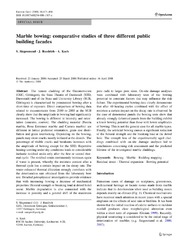Marble bowing: comparative studies of three different public building facades
Siegesmund, S.
Ruedrich, J.
Koch, A.
56, 3/4: 473 - 494
DOI: https://doi.org/10.1007/s00254-008-1307-z
Persistent URL: http://resolver.sub.uni-goettingen.de/purl?gldocs-11858/6735
Persistent URL: http://resolver.sub.uni-goettingen.de/purl?gldocs-11858/6735
Siegesmund, S.; Ruedrich, J.; Koch, A., 2008: Marble bowing: comparative studies of three different public building facades. In: Siegesmund, S.; Ruedrich, J.; Koch, A. (2008): Marble bowing: comparative studies of three different public building facades - Environmental geology; Vol. 56, Nr. 3/4, p. 473-494, DOI: 10.1007/s00254-008-1307-z.
 |
Dokument öffnen: |
The veneer cladding of the Oeconomicum (OEC, Göttingen), the State Theatre of Darmstadt (STD, Darmstadt) and of the State and University Library (SUB, Göttingen) is characterised by pronounced bowing after a short time of exposure. Direct comparison of bowing data related to measurements from 2000 to 2003 at the SUB clearly show that the amplitude in bowing had significantly increased. The bowing is different in intensity and orientation (concave, convex). The cladding material (Peccia marble, Rosa Estremoz marble and Carrara marble) are different in lattice preferred orientation, grain size distribution and grain interlocking. Depending on the bowing, panels may show cracks mostly initiated at the dowels. The percentage of visible cracks and breakouts increases with the amplitude of bowing except for the STD. Repetitive heatingcooling under dry conditions leads to considerable inelastic residual strain only after the first or second thermal cycle. The residual strain continuously increases again if water is present, whereby the moisture content after a thermal cycle has a certain impact on the decay rate. The water-enhanced thermal dilatation strongly correlates with the deterioration rate obtained from the laboratory bow test. Detailed petrophysical investigations provide evidence that with increasing bowing a decrease of mechanical properties (flexural strength or breaking load at dowel hole) occur. Marble degradation is also connected with the increase in porosity and a general shift of the maximum pore radii to larger pore sizes...
Statistik:
ZugriffsstatistikSammlung:
- Geologie [930]

